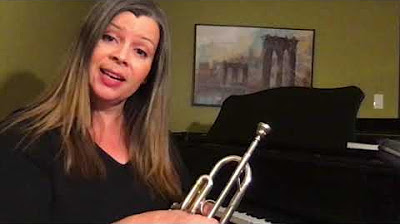Learn How to Play Note D on the French Horn
Summary
TLDRThis instructional video for French horn players focuses on mastering the high D note. The script emphasizes the importance of embouchure, using fast air, and firm lips. It suggests practicing the EE tongue position and comparing it to playing a high C. The video instructs viewers to buzz the note before playing it, ensuring they match pitch with their ear. The exercise involves playing a whole note, pausing, and repeating, with an emphasis on listening to improve accuracy. The instructor encourages practice, promising improvement with dedication.
Takeaways
- 🎷 Focus on embouchure for playing high D on the French horn.
- 💨 Use fast air and a firmer embouchure to achieve high notes.
- 🏁 Think about faster air support when playing high D.
- 👄 Ensure firm corners and an 'EE' tongue position for high notes.
- 🎼 Compare the embouchure for high C and high D, as they are similar.
- 🤞 Fingering for both C and D is the same: no valves down.
- 🔊 Buzzing is crucial; it helps in playing high notes effectively.
- 👂 Use good listening skills to match the pitch while buzzing.
- 📝 Practice buzzing whole notes with breaks to improve accuracy.
- 🎉 Celebrate success in playing high D and continue practicing for consistency.
Q & A
What is the main focus of this video for French horn players?
-The main focus of this video is to help French horn players tackle the high D note, emphasizing the importance of embouchure and proper technique.
What does the instructor suggest for achieving a high D note?
-The instructor suggests using fast air, a firmer embouchure, and even thinking about a faster air stream to help achieve the high D note.
Why is having firm corners important when playing the French horn?
-Having firm corners is important for controlling the airflow and achieving the correct pitch, especially when playing high notes like the high D.
What role does the tongue play in playing the high D on the French horn?
-The tongue should be positioned in an 'EE' shape, which helps in producing the high D note.
How is the embouchure for playing a high C similar to that of a high D?
-The embouchure for playing a high C is similar to a high D in that both are high notes requiring a focused and precise embouchure.
What is the fingering for playing a high C and a high D on the French horn?
-The fingering for both high C and high D is with no valves down.
Why is buzzing important before playing the high D note?
-Buzzing is important because it helps players to achieve the correct pitch and embouchure without the mouthpiece, ensuring they can play the note accurately when they do put the mouthpiece in.
What exercise does the instructor recommend to practice buzzing for the high D note?
-The instructor recommends buzzing a whole note, taking a break, and then buzzing another whole note to practice for the high D note.
How does the instructor encourage the listener after they successfully buzz the high D note?
-The instructor encourages the listener by affirming their success and readiness to play the high D note on the French horn.
What is the final advice given by the instructor to improve playing the high D note?
-The final advice is to keep practicing, go back to buzzing, play the note again, and ensure to use good listening skills to match the pitch heard.
What is the overall message the instructor conveys to French horn players at the end of the video?
-The overall message is to keep working hard, keep practicing, and most importantly, to continue making music.
Outlines

هذا القسم متوفر فقط للمشتركين. يرجى الترقية للوصول إلى هذه الميزة.
قم بالترقية الآنMindmap

هذا القسم متوفر فقط للمشتركين. يرجى الترقية للوصول إلى هذه الميزة.
قم بالترقية الآنKeywords

هذا القسم متوفر فقط للمشتركين. يرجى الترقية للوصول إلى هذه الميزة.
قم بالترقية الآنHighlights

هذا القسم متوفر فقط للمشتركين. يرجى الترقية للوصول إلى هذه الميزة.
قم بالترقية الآنTranscripts

هذا القسم متوفر فقط للمشتركين. يرجى الترقية للوصول إلى هذه الميزة.
قم بالترقية الآن5.0 / 5 (0 votes)






